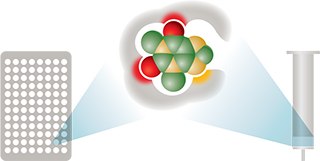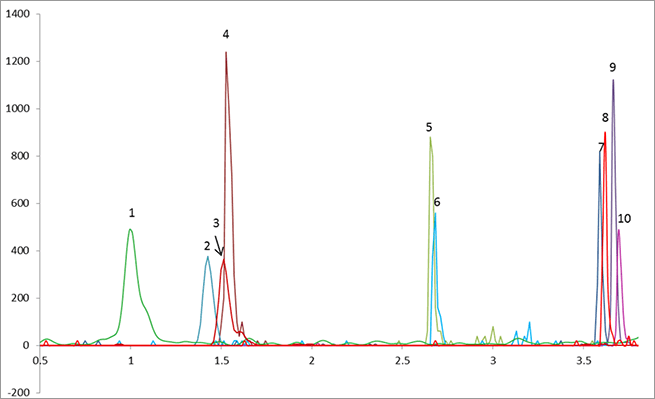SupelMIP Molecularly Imprinted Polymer SPE Cartridges
SupelMIP SPE is based on molecularly imprinted polymer (MIP) technology. Each SupelMIP phase offers tailor-made selectivity for the extraction of trace analytes in complex matrixes. Its superior cleanup and selectivity provide faster/simpler sample prep methods, better MS compatibility (reduced ion suppression) allowing analysts to achieve lower detection limits and improved sensitivity.

MIPs are highly cross-linked polymer phases that have pre-determined selectivity for a single analyte or a group of structurally related analytes.
The SupelMIP SPE products consist of highly cross-linked polymers that are engineered to extract a single analyte of interest or a class of structurally related analytes of interest with an extremely high degree of selectivity. This is possible because selectivity is introduced during MIP synthesis in which a template molecule, designed to mimic the analyte, guides the formation of specific cavities or imprints that are sterically and chemically complementary to the analyte(s) of interest.
The Benefits of SupelMIP SPE
- Achieve lower detection limits through superior selectivity
- Save time and reduce cost via robust and rapid methodology
- Stable at broad pH ranges and high temperatures
- Reduce ion suppression
SupelMIP SPE Binding Site

MIP binding site is both chemically and sterically complementary to the analyte(s) of interest. Multiple non-covalent interaction points (ion-exchange, reversed-phase with polymer backbone, and hydrogen bonding) between the MIP phase and analyte functional groups allow for stronger analyte retention. Improved selectivity is then introduced through the use of harsher wash conditions during sample prep methodology.
Superior Selectivity Yields Lower Detection Limits
By careful design of the imprinting site, either by molecular modeling, experimental design, or screening methods, the binding cavities can be engineered to offer multiple interaction points with the analyte(s) of interest. This leads to a stronger interaction between the sorbent and the analyte(s). As a consequence, harsher wash conditions can be tolerated during SPE methodology resulting in cleaner extracts. Because extraction selectivity is significantly improved, lower background is observed allowing analysts to achieve lower detection limits.
The example below demonstrates the successful use of the highly selective MIP solid phase extraction technique followed by LC-MS/MS analysis for the quantitative determination of aminoglycoside antibiotics in porcine tissue. The unique selectivity of the MIP material facilitated the removal of matrix interference prior to elution of the analytes of interest.
LC/MS/MS of Aminoglycosides in Pork Muscle after SupelMIP SPE Cleanup

Sample: Pork muscle spiked with 100 ng/g of aminoglycosides; 3 mL of extract
Peak IDs: 1. Spectinomycin, 2. Hygromycin B, 3. Streptomycin, 4. Dihydrostreptomycin, 5. Amikacin, 6. Kanamycin, 7. Apramycin, 8. Tobramycin, 9. Gentamicin, 10. Neomycin
Robust and Rapid Methodology
Sample preparation is often the rate-limiting step within the analytical process, and can often take up to 10 times as long as the analysis in itself. It is therefore critical for analysts to develop simple, robust, and rapid extraction techniques that are selective enough to achieve sensitivity, precision, and accuracy limits required of the assay.
Stable at Broad pH Ranges and High Temperatures
MIPs are highly cross-linked polymers that maintain stability when exposed to a broad range of organic solvents, can withstand high temperatures, and can be used over broad pH ranges, without loss of selectivity. Furthermore, they can be stored at room temperatures for prolonged periods of times. This is extremely advantageous over immunoaffinity based products.
SupelMIP SPE Minimizes Ion Suppression
Mass spectrometry is a powerful quantitative tool that has been introduced into most clinical and research laboratories in recent years. When coupled to HPLC (LC-MS), the technique offers sensitivity, speed, and specificity.
Ion suppression is a common and problematic phenomenon that occurs when analyzing trace levels of analyte(s) in complex matrixes such as biological fluids. As analytical runtimes are reduced, ion suppression can often become more prevalent manifesting as poor assay accuracy and precision. Because ion suppression is often caused by the co-elution of matrix components with analyte(s) of interest, improved selectivity/sample cleanup during sample preparation is critical. Because selectivity is tailor-made during the design and production of a SupelMIP SPE phase, ion suppression is often reduced when compared to more conventional SPE phases.
如要继续阅读,请登录或创建帐户。
暂无帐户?